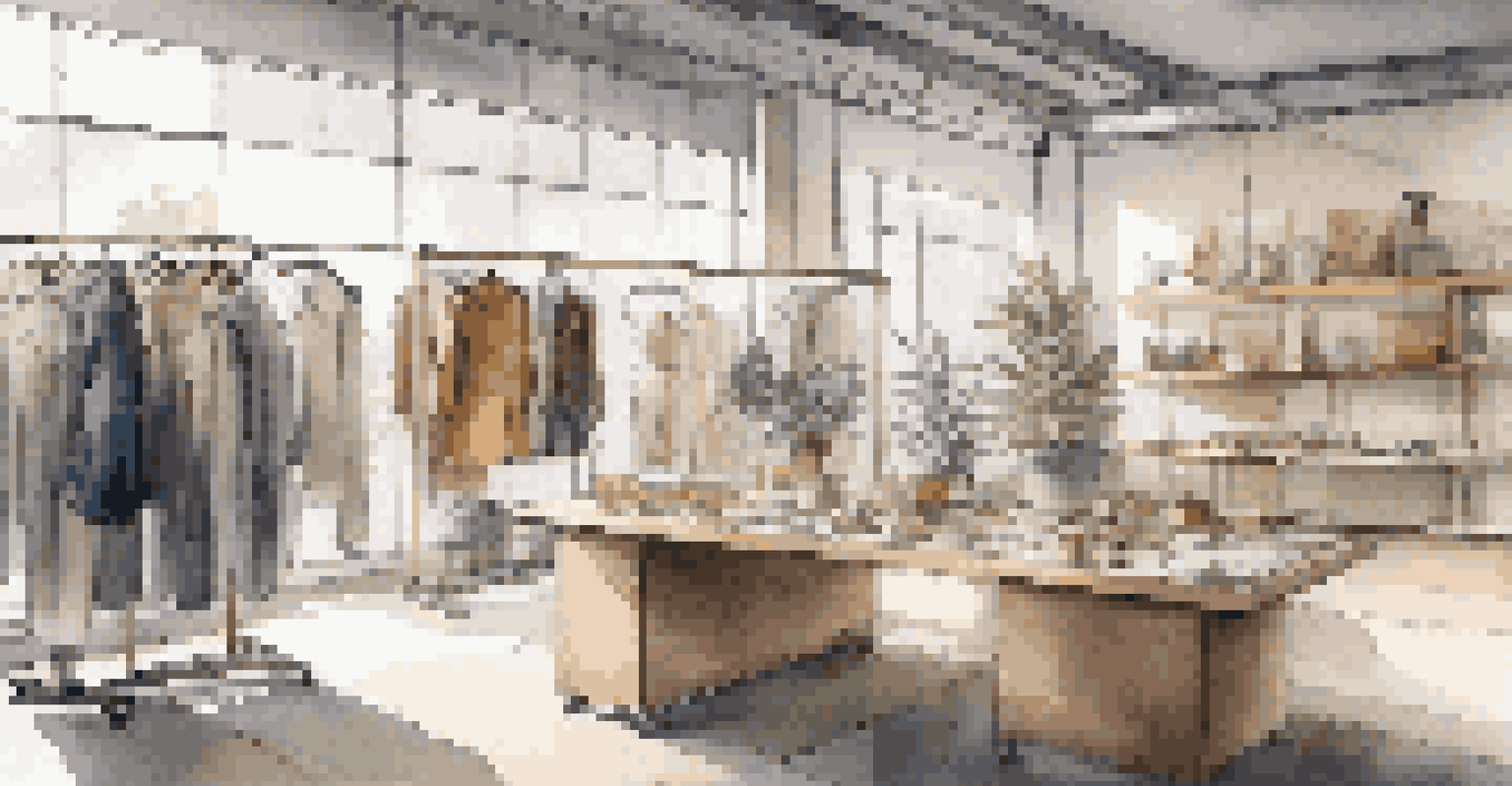Exploring the Link Between Luxury Fashion and Biodiversity

Understanding Luxury Fashion's Environmental Footprint
Luxury fashion is often seen as synonymous with high quality and exclusivity, but it comes with a significant environmental impact. From resource-intensive materials to complex supply chains, the production of luxury goods can strain our planet's biodiversity. For instance, the sourcing of exotic leathers or rare materials can lead to habitat destruction and threaten species.
Fashion is about dreaming and making other people dream. But if we keep doing it the way we are, we will have no planet to dream about.
Moreover, the fast-paced nature of fashion trends encourages overproduction and waste, putting even more pressure on ecosystems. Many luxury brands are now grappling with the need to balance their allure with sustainable practices. As consumers become more aware, there's a growing demand for transparency in how these brands operate.
Ultimately, understanding this footprint is the first step toward advocating for change within the industry. By shedding light on the environmental costs of luxury fashion, we can begin to appreciate the delicate balance between style and sustainability.
The Role of Biodiversity in Fashion Supply Chains
Biodiversity plays a crucial role in the fashion supply chain, influencing everything from material sourcing to production methods. Healthy ecosystems provide the raw materials needed for textiles, dyes, and other components of luxury fashion. For example, cotton, a staple in many luxury garments, relies on diverse insect populations for pollination.

When biodiversity is compromised, the entire supply chain can be disrupted, leading to quality issues and increased costs. This interdependence highlights the importance of protecting natural habitats and species, not just for the sake of the environment but for the longevity of the fashion industry itself. Brands that recognize this relationship are better positioned to thrive in a sustainable future.
Luxury Fashion's Environmental Impact
The production of luxury fashion significantly strains biodiversity through resource-intensive practices and overproduction.
By integrating biodiversity considerations into their business models, luxury brands can foster resilience and innovation. This approach not only benefits the planet but also enhances the brand's reputation among environmentally conscious consumers.
Case Studies: Brands Leading the Charge in Sustainability
Several luxury fashion brands are making strides in sustainability by prioritizing biodiversity. For instance, Stella McCartney has long been an advocate for animal rights and eco-friendly practices, using materials like organic cotton and recycled polyester. Their commitment to sustainable sourcing sets a benchmark for other brands in the industry.
Sustainability is about how we do business. It’s not a separate program, it’s the way we think.
Similarly, Gucci has launched initiatives aimed at reducing its environmental impact, including a partnership with the non-profit organization The Lion's Share. This collaboration focuses on protecting wildlife and their habitats, showcasing how luxury brands can contribute positively to global biodiversity efforts. These case studies serve as inspiring examples for others to follow.
By championing sustainability, these brands not only enhance their image but also create a ripple effect, encouraging consumers to make more mindful choices. As the luxury market evolves, it is clear that a commitment to biodiversity can be a unique selling point.
Consumer Awareness and Demand for Sustainable Fashion
Today's consumers are more aware than ever of the environmental repercussions of their purchases, including those in the luxury fashion sector. This shift in mindset has led to increased demand for brands that prioritize sustainability and biodiversity. Customers are actively seeking out options that minimize harm to the planet and support ethical practices.
Social media plays a significant role in this movement, enabling consumers to share information and hold brands accountable. This transparency is crucial as luxury brands navigate the complexities of sustainability. Shoppers are no longer just buying products; they are investing in values and principles that align with their own.
Biodiversity's Role in Supply Chains
Healthy ecosystems are essential for luxury fashion, as they provide the raw materials necessary for production, emphasizing the need for biodiversity protection.
As a result, luxury fashion brands are beginning to adapt their strategies to meet this demand. By showcasing their efforts in sustainability and biodiversity, they can attract a loyal customer base that prioritizes ethical consumption.
The Impact of Climate Change on Fashion and Biodiversity
Climate change poses a significant threat to biodiversity and, in turn, the luxury fashion industry. Rising temperatures and extreme weather events can disrupt the availability of raw materials, affecting everything from cotton harvests to the sourcing of rare fibers. This unpredictability can lead to scarcity, driving up prices and impacting the production process.
Furthermore, as habitats shift due to climate change, many species face the risk of extinction. This loss of biodiversity can have dire consequences for the fashion industry, as it relies on a wide array of natural resources. Brands must recognize the interconnectedness of climate change and biodiversity to develop effective strategies for adaptation.
To mitigate these risks, luxury fashion brands are increasingly looking to sustainable practices and innovative technologies. By investing in eco-friendly materials and practices, they can reduce their carbon footprint while safeguarding the planet's biodiversity.
Innovative Materials: The Future of Eco-Friendly Luxury Fashion
The future of luxury fashion lies in the adoption of innovative, eco-friendly materials that respect biodiversity. Brands are exploring alternatives like lab-grown leather, recycled fabrics, and plant-based dyes, which significantly lessen their environmental impact. These materials not only reduce reliance on finite resources but also offer unique selling points for eco-conscious consumers.
For example, companies like MycoWorks are pioneering the use of mycelium, the root structure of mushrooms, as a sustainable leather alternative. This innovation not only helps reduce deforestation but also fosters biodiversity by promoting the growth of fungi. As these materials gain acceptance, they could revolutionize the luxury fashion landscape.
Consumer Demand for Sustainability
Today's consumers increasingly prioritize sustainable practices in luxury fashion, pushing brands to adapt and promote their commitment to biodiversity.
By embracing these innovative solutions, luxury brands can position themselves as leaders in sustainability, attracting customers who are eager to support environmentally friendly practices. This shift not only benefits the planet but also creates a competitive edge in a rapidly changing market.
The Importance of Collaboration in Promoting Biodiversity
Collaboration is key in the effort to promote biodiversity within the luxury fashion industry. Brands, NGOs, and governments must work together to create comprehensive frameworks that protect ecosystems while supporting sustainable practices. By pooling resources and expertise, these stakeholders can develop effective strategies to tackle the challenges facing biodiversity.
For instance, partnerships between luxury brands and environmental organizations can lead to initiatives that restore habitats and support endangered species. These collaborations not only enhance the brand's reputation but also contribute to meaningful change in the industry. The impact of such efforts can be profound, inspiring others to follow suit.

Ultimately, fostering collaboration can create a ripple effect that extends beyond fashion, encouraging broader societal movements toward sustainability. As brands unite for a common cause, they can amplify their influence and drive significant progress in protecting our planet's precious biodiversity.